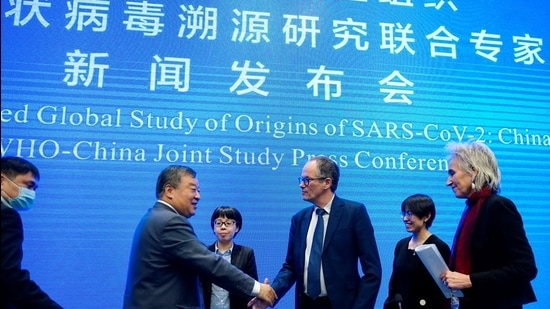Covid virus lab leak unlikely, may have taken ‘convoluted path’ to Wuhan: WHO
Liang Wannian, an expert with China’s National Health Commission (NHC), said there had been no substantial spread of the virus in the city before late 2019 outbreak.
The Covid-19 virus could have been circulating in other regions before it was identified in the central Chinese city of Wuhan at the end of 2019, a top expert at China’s health authority said on Tuesday.

Liang Wannian, an expert with China’s national health commission (NHC), said there had been no substantial spread of the virus in the city before late 2019 outbreak.
“This indicates the possibility of the missed reported circulation in other regions,” Liang, the Chinese lead of the international team convened by the World Health Organization (WHO), said during a press conference at the end of the probe by the international group.
Liang said the joint Chinese and WHO team of 34 experts believe the virus originated in an animal, “but the reservoir host remains to be identified”.
However, researchers did find evidence of wider Covid-19 circulation outside the Huanan seafood market – linked to a few of the first cases of the virus – that same month, said Peter Ben Embarek, the WHO’s food safety and animal disease specialist and chairperson of the investigation team.
“The possible path from whatever original animal species all the way through to the Huanan market could have taken a very long and convoluted path involving also movements across borders,” Embarek told the nearly three-hour media briefing.
The first cases of a pneumonia-like viral infection were reported in Wuhan, a city of 11 million people in the central Chinese province of Hubei, in December 2019.
Embarek added it was not possible yet to pinpoint the animal intermediary host for the coronavirus, describing the findings as “work in progress.”
The current theory is that the virus originally circulated in bats or pangolins.
Liang said the onset date of the earliest Covid-19 case had been on December 8, 2019 and the earliest case associated with the Huanan market was on December 12, 2019.
The Chinese expert said: “The case with the onset date of December 8 case had no relation with Huanan seafood market”.
Liang did not give a location that the December 8 case was connected to.
“In terms of understanding what happened in the early days of December 2019, did we change dramatically the picture we had beforehand? I don’t think so,” Embarek said. “Did we improve our understanding? Did we add details to that story? Absolutely.”
The China-WHO expert team, which reached Wuhan on January 14 and then quarantined for two weeks, subsequently visited markets, hospitals, research centres and interacted with scientists and experts.
Embarek said that “four main hypotheses or groups of hypotheses” have been identified on how the Covid-19 virus might have been introduced among humans: direct zoonotic spillover; introduction through intermediary host species; food chain, frozen food products, surface transmission and a laboratory-related incident.
The theory that the coronavirus was leaked from the Wuhan Institute of Virology – China’s high-security bio-safety lab visited by the team – was not given credence by the investigators.
“The laboratory incident hypothesis is extremely unlikely to explain the introduction of the virus into the human population,” Ben Embarek said. “Therefore, it is not in the hypotheses that we will suggest for future studies.”
The team had reached the conclusion that a lab leak should be regarded as extremely unlikely “on the basis of a serious discussion and very diligent research,” he added.
“Our initial findings suggest that introduction through an intermediary host species is the most likely pathway and one that will require more studies and more specific targeted research ... The findings suggest that a laboratory incident hypothesis is extremely unlikely to explain the introduction of the virus into the human population,” the WHO expert said.





